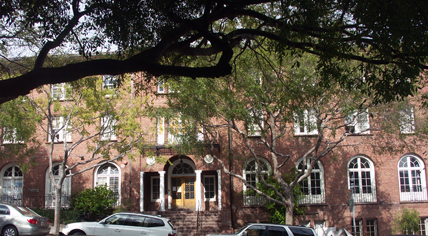By Jarrod Shappell
If you live in the area, I assume that you have seen the tall classical arches and open atrium of 300 Page St. The beauty of the San Francisco Zen Center, designed by Julia Morgan in 1922, has beckoned me for months, so I recently scheduled a tour.
Upon arriving for my tour I was met by a Zen Priest wearing her robes. She told me that she was on her way to the OccupySF rally and that someone else would have to show me around. She apologized profusely and quickly left. A Zen Priest canceled on me for a protest – not what I expected. Throughout my day I would discover that most of my Zen expectations were misguided and that the beauty of the Zen Center was in its awareness to the needs and activities of neighbor and city.
The San Francisco Zen Center was founded in 1969 by Shunryu Suzuki and practices what they call “engaged Buddhism.” This hospitable posture towards the community began when Suzuki, a small man (as depicted by the life-size art piece in the Zen Center today), invited English-speaking young American students, with no previous Zen training, to sit with him and the Japanese community in a Japanese temple on Bush Street. Suzuki’s practice attracted the spiritually curious beatniks and together they formed one of America’s first zen communities. His hope for this group, or “sangha,” was that their practice would open them up to the diverse and changing world.
My tour with Myoki, my very inviting and informative guide, began with an experience and explanation of zazen meditation. Zazen is a way of “just sitting” that is an invitation to both rest and center, and is central to the Soto Zen school of practice. Taking off my shoes, I walked into the Buddha room. Just being in the dark room peppered with floor pillows lowered
my heart rate. The Zen Center offers free meditation instruction every Saturday morning at 8:30 am, and according to Myoki, each week is different so you can go back more than once and get a different perspective.
After several moments in the Buddha room, we moved to the ornate and tranquil patio garden. Central to the garden is a solar powered fountain. On this sunny October day the water was flowing steadily. The wind spun around the trees, each planted to honor a new abbot as they joined the Zen Center. At the foot of the trees are newly planted edibles that the staff uses for meals (which are available for under $10 for class or meditation participants). The space is both an invitation to peace and an embodiment of their love for the
earth.
After begrudgingly exiting the sunny patio, I made my way downstairs and nearly ran into a marching band size set of instruments. These beautiful bells and drums are essential to setting the rhythms of their practice. The slow rumble of the “han drum” was a call to meditation. The ringing “densho bell” an invitation to zazen. As these instruments resonated I couldn’t help
but feel like the Zen Center has been keeping rhythm for Hayes Valley all along, and most of us just don’t know it.
At the Zen Center you get the sense that they really want their space, classes, and practice to invite the neighborhood into this spiritual rhythm. This is seen in all of their current offerings, which include classes, tours, an the very popular Dharma Talks (Saturday, 10:15 a.m.). They have offerings for specific demographics such as the Young Urban Zen group and the Queer Dharma group, and classes such as Meditation in Recovery.
After a trip past the kitchen and through a classroom, Myoki and I walked the stairs to the roof. What a view! Living in a valley you forget the views offered to you by our city’s hills. Sitting in my chair, looking past solar panels and their very own bee colony, I could see all of Hayes Valley. As I sat thinking about all that the Zen Center offers to our community, I was struck by the view. There are few, if any, places with a view of Hayes Valley like the Zen Center. And for me, this is the unique gift that the Zen Center offers our community: perspective.

